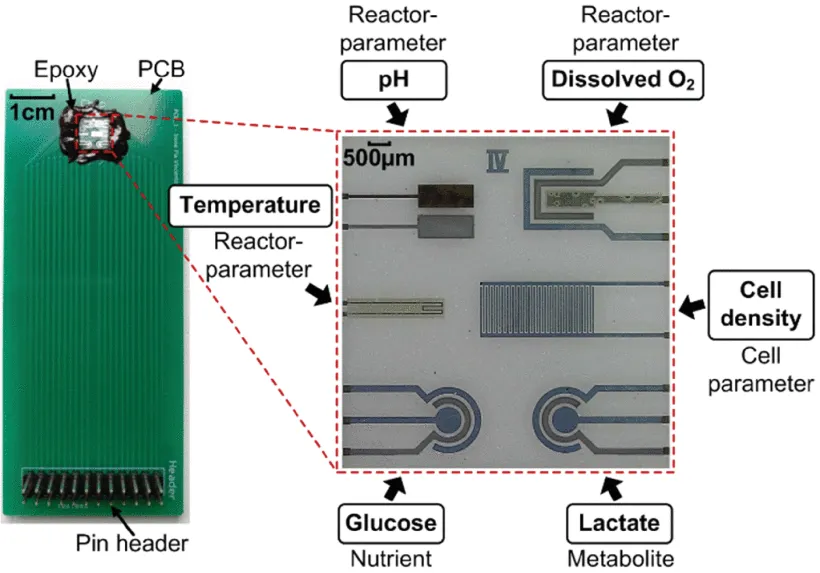Multi-Sensor Chip for Monitoring Key Parameters in Bioprocesses
The possibility to fabricate multiple microsensors on a single chip using a wafer-level microfabrication process has enabled miniaturisation and led to the development of multiparametric electrochemical (bio)sensors devices. It made the integration of six electrochemical biosensors on a single chip feasible. Their outputs are based on either amperometric, potentiometric and impedimetric/conductometric detection techniques. Hence this single chip can measure and monitor essential bioprocess parameters like glucose, lactate, pH, cell density, dissolved oxygen concentration, and temperature.
The selection of the types of sensors, analytical methods, configuration and microfabricated sensors’ design on the multi-panel platform are based on: (1) easier integration with other sensors and better compatibility with the additive fabrication technology, (2) comprehensive sensing range and faster response with comparable sensitivity, and (3) cost-effectiveness.
The prototype comprising of six sensors were fabricated using a four-mask process on a 7x7 mm2 single chip to monitor glucose, lactate, pH, cell density, dO2, and temperature. It was fabricated with Pt, Au, and Ag electrodes with a patterned Parylene-C insulating layer on the glass substrate. Each metal layer served multi-purposes across the different sensors, thus limiting fabrication complexity.
When the fabricated enzyme sensors were electrically tested for glucose and lactate for a concentration of 0.5 mM and 60 mM of glucose and lactate, the chronoamperometric (CA) responses of the glucose sensor and lactate sensor increased linearly up to 10mM with a fast response time of 20s for both the sensors. It was fast enough for real-time measurements for their levels. However, at higher concentrations, the current response became constant due to the saturation of the enzymatic reaction.
Polymer-based polyaniline (PANI) modified potentiometric pH electrodes were chosen for pH sensors because they are biocompatible, easy to fabricate, stable, cheap, and have small-footprint. A near-Nernstian equation governed the integrated pH sensors with an average sensitivity of 60.8 ± 2.4 mV/pH between pH of 4 and 10 with a high linear regression coefficient. However, the pH sensors showed strong deprotonation at pH > 9, which limited the use of PANI as a potentiometric pH sensor to measure the pH values between 2 and 9.
The experimental results obtained with cell density, dissolved oxygen, and temperature sensors also showed a promising step towards a real-time and parallel in-situ measurement. These three sensors were also electrically tested. The cell density sensor showed an ohmic plateau from approximately 150kHz – 10MHz, with the curve providing a suitable frequency range for real-time cell density measurements. The microelectrode array (MEA) dissolved oxygen sensor operating on an amperometry technique showed a good linear correlation (R2 = 0.9978) as the absolute average current detected in oxygen-deprived Phosphate-buffered saline (PBS) increased with an increase in the dissolved oxygen (dO2) concentration. The integrated resistance temperature device showed the capability for temperature monitoring in bioprocesses when an electrical current was passed through it. With the increase in temperature from 100C to 700 C, the resistance increased.
The development of integrated design and microfabrication technology enabled compact measurement setup. It also reduces device footprint and cost. With enhanced integrated sensors' functionality and operability, it is commercially viable for application in a wireless, IoT-style sensor node. It has found applications in wearable electronics, home automation systems, food, process, health and environmental monitoring.




